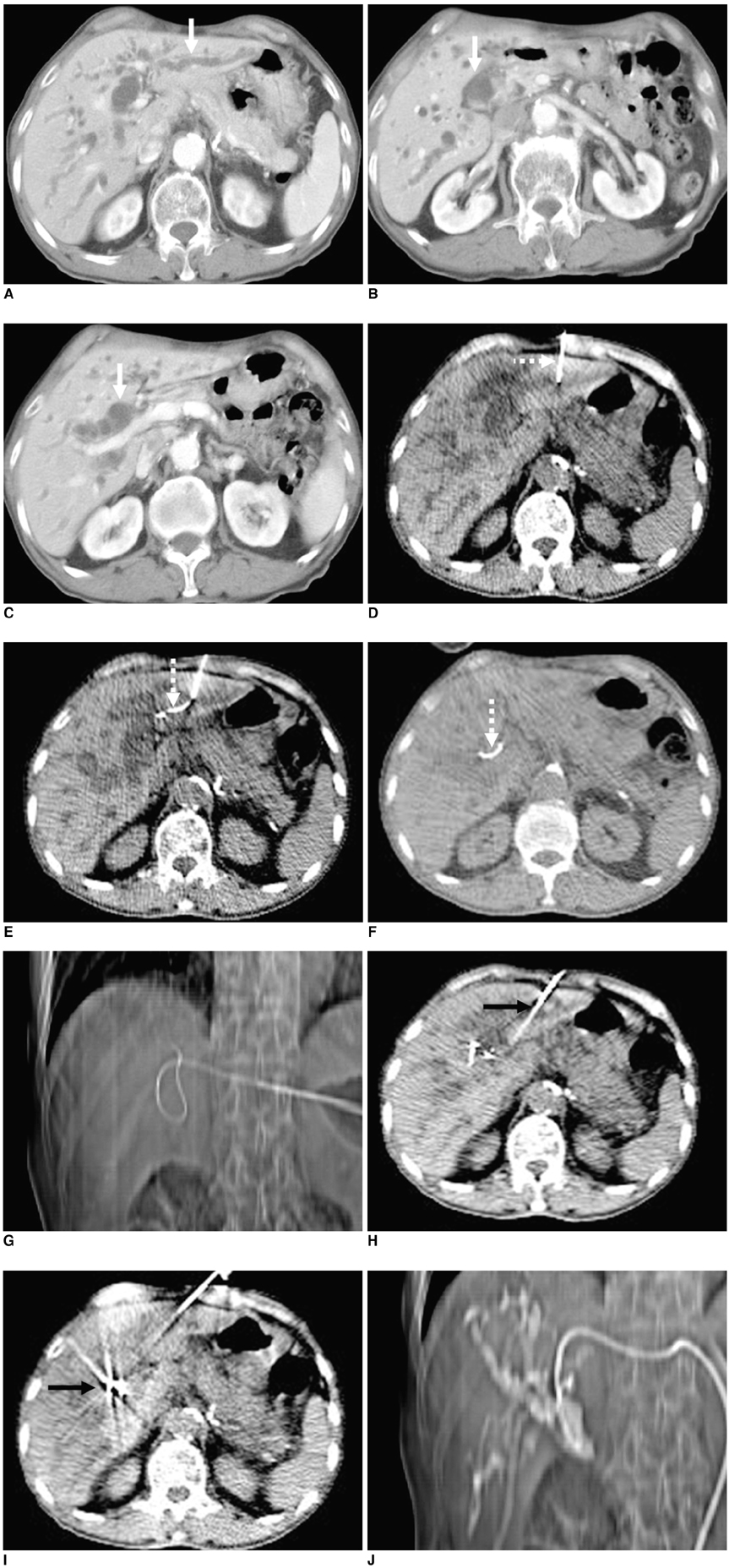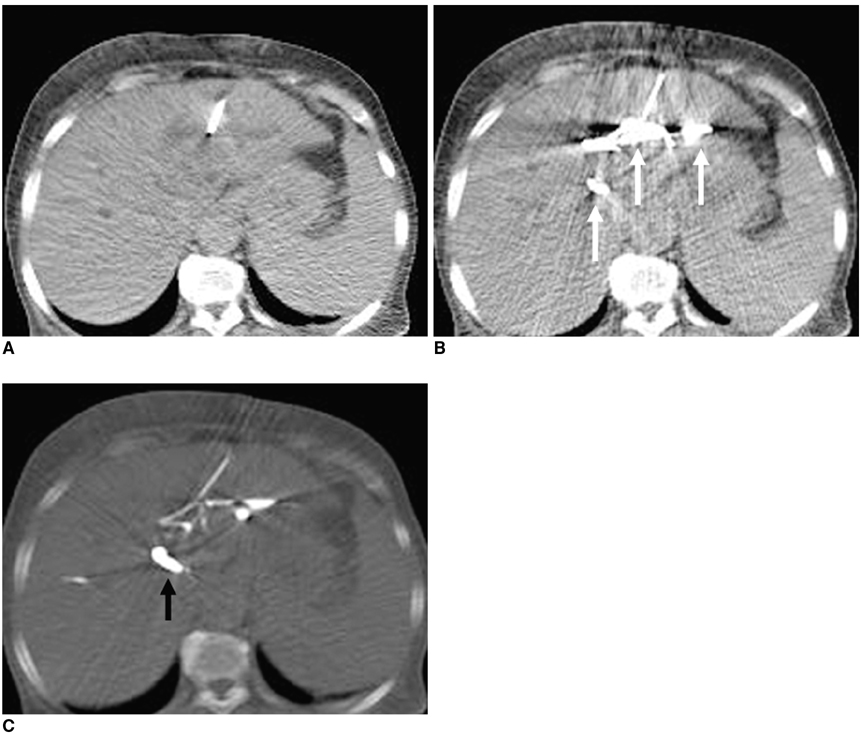Korean J Radiol.
2009 Apr;10(2):144-149. 10.3348/kjr.2009.10.2.144.
Clinical Feasibility and Usefulness of CT Fluoroscopy-Guided Percutaneous Transhepatic Biliary Drainage in Emergency Patients with Acute Obstructive Cholangitis
- Affiliations
-
- 1Department of Radiology, Sam Anyang Hospital, Kyungki-do 430-733, Korea. radol@unitel.co.kr
- 2Department of Radiology, Konyang University Hospital, Daejon 305-718, Korea.
- KMID: 1088725
- DOI: http://doi.org/10.3348/kjr.2009.10.2.144
Abstract
OBJECTIVE
To evaluate the feasibility of CT fluoroscopy (CTF)-guided percutaneous transhepatic biliary drainage (PTBD) in emergency patients with acute obstructive cholangitis.
MATERIALS AND METHODS
The study included 28 patients admitted to the emergency center due to obstructive jaundice and found to require urgent biliary drainage, as well as judged to have a suitable peripheral bile duct for a CTF-guided puncture (at least 4 mm in width). Prior to the CTF-guided puncture, a CT scan was performed to evaluate bile duct dilatation and the underlying causes of biliary obstruction. If the patient was judged to be a suitable candidate, a CTF-guided PTBD was performed in the same CT unit without additional fluoroscopic guidance. Technical feasibility of the procedure was investigated with the evaluation of overall success rate and causes of failure.
RESULTS
A hepatic puncture was attempted at the left lobe in 23 patients and right lobe in five patients. The procedure was successful in 24 of 28 patients (86%) Successful biliary puncture was achieved on the first attempt in 16 patients, the second attempt in five patients, and the third attempt in three patients. The causes of failure included guide wire twisting in one patient, biliary puncture failure in two patients, and poor visualization of the guide wire in one patient. There were no significant procedure-related complication.
CONCLUSION
The CTF-guided PTBD is technically feasible and highly successful in patients judged to have a suitable indication. Moreover, although the procedure is unfamiliar and inconvenient to interventionalists, it has economical advantages in that it saves time and manpower. We believe this method can be used in the emergency patients requiring urgent biliary drainage as an alternative for the fluoroscopy-guided PTBD.
Keyword
MeSH Terms
Figure
Cited by 1 articles
-
Percutaneous Biliary Drainage Using Open Cell Stents for Malignant Biliary Hilar Obstruction
Sun Jun Ahn, Jae Ik Bae, Tae Sun Han, Je Hwan Won, Ji Dae Kim, Kyu-Sung Kwack, Jae Hee Lee, Young Chul Kim
Korean J Radiol. 2012;13(6):795-802. doi: 10.3348/kjr.2012.13.6.795.
Reference
-
1. Katada K, Anno H, Takeshita G, Ogura Y, Koga S, Ida Y, et al. Development of real-time CT fluoroscopy. Nippon Igaku Hoshasen Gakkai Zasshi. 1994. 54:1172–1174.2. Katada K, Kato R, Anno H, Ogura Y, Koga S, Ida Y, et al. Guidance with real-time CT fluoroscopy: early clinical experience. Radiology. 1996. 200:851–856.3. White CS, Templeton PA, Hasday JD. CT-assisted tranbronchial needle aspiration: usefulness of CT fluoroscopy. AJR Am J Roentgenol. 1997. 169:393–394.4. Froelich JJ, Saar B, Hoppe M, Ishaque N, Walthers EM, Regn J, et al. Real-time CT fluoroscopy for guidance of percutaneous drainage procedures. J Vasc Interv Radiol. 1998. 9:735–740.5. Silverman SG, Tuncali K, Adams DF, Nawfel RD, Zou KH, Judy PF. CT fluoroscopy-guided abdominal interventions: technique, results and radiation exposure. Radiology. 1999. 212:673–681.6. Daly B, Krebs TL, Wong-You-Cheong JJ, Wang SS. Percutaneous abdominal and pelvic interventional procedures using CT fluoroscopy guidance. AJR Am J Roentgenol. 1999. 173:637–644.7. Kirchner J, Kickuth R, Walz MV, Schilling EM, Laufer U, Liermann D. CTF-guided puncture of an unenhanced isodense liver lesion during continuous intravenous injection of contrast medium. Cardiovasc Intervent Radiol. 1999. 22:528–530.8. Muehlstaedt M, Bruening R, Diebold J, Mueller A, Helmberger T, Reiser M. CT/fluoroscopy-guided transthoracic needle biopsy: sensitivity and complication rate in 98 procedures. J Comput Assist Tomogr. 2002. 26:191–196.9. Davies RP, Kew J, West GP. Percutaneous jejunostomy using CT fluoroscopy. AJR Am J Roentgenol. 2001. 176:808–810.10. Ernst RD, Kim HS, Kawashima A, Middlebrook MR, Sandler CM. Near Real-time CT fluoroscopy using computer automated scan technology in nonvascular interventional procedures. AJR Am J Roentgenol. 2000. 174:319–321.11. Froelich JJ, Wagner HJ, Ishaque N, Alfke H, Scherf C, Klose KJ. Comparison of C-arm CT fluoroscopy and conventional fluoroscopy for percutaneous biliary drainage procedures. J Vasc Interv Radiol. 2000. 11:477–482.12. Laufer U, Kirchner J, Kickuth R, Adams S, Liermann D. First experiences in CT-guided percutaneous transhepatic biliary decompression by means of real-time CT fluoroscopy. Abdom Imaging. 2001. 26:207–209.13. Laufer U, Kirchner J, Kickuth R, Adams S, Jendreck M, Liermann D. A comparative study of CT fluoroscopy combined with fluoroscopy versus fluoroscopy alone for percutaneous transhepatic biliary drainage. Cardiovasc Intervent Radiol. 2001. 24:240–244.14. Kato R, Katada K, Anno H, Suzuki S, Ida Y, Koga S. Radiation dosimetry at CT fluoroscopy: physician's hand dose and development of needle holders. Radiology. 1996. 201:576–578.15. Stoeckelhuber BM, Leibecke T, Schulz E, Melchert UH, Bergmann-Koester CU, Helmberger T, et al. Radiation dose to the radiologist's hand during continuous CT fluoroscopy-guided interventions. Cardiovasc Intervent Radiol. 2005. 28:589–594.16. Murphy K, Baez JC, Cooney B, Kabaish K. CT fluoroscopy-guided postmyelographic transthecal radiofrequency ablation of a posterior vertebral body osteoid osteoma. J Vasc Interv Radiol. 2008. 19:291–293.17. Schaefer PJ, Schaefer FK, Heller M, Jahnke T. CT fluoroscopy guided biopsy of small pulmonary and upper abdominal lesions: efficacy with a modified breathing technique. J Vasc Interv Radiol. 2007. 18:1241–1248.18. Bladt O, De Wever W. Additional value of CT-fluoroscopic biopsy of pulmonary lesions: a retrospective study of 69 patients. JBR-BTR. 2006. 89:298–302.19. Hamuro M, Kaminou T, Nakamura K, Matsuoka T, Sakai Y, Morimoto A, et al. Percutaneous ethanol injection under CT fluoroscopy for hypervascular hepatocellular carcinoma following transcatheter arterial embolization. Hepatogastroenterology. 2002. 49:752–757.20. Tay VK, Fitridge R, Tie ML. Computed tomography fluoroscopy-guided chemical lumbar sympathectomy: simple, safe and effective. Australas Radiol. 2002. 46:163–166.21. Carlson SK, Bender CE, Classic KL, Zink FE, Quam JP, Ward EM, et al. Benefits and safety of CT fluoroscopy in interventional radiologic procedures. Radiology. 2001. 219:515–529.
- Full Text Links
- Actions
-
Cited
- CITED
-
- Close
- Share
- Similar articles
-
- Percutaneous biliary drainage in acute suppurative cholangitis with biliary sepsis
- Percutaneous transhepatic biliary drainage
- Acute Obstructive Cholangitis after Transarterial Chemoembolization: the Effect of Percutaneous Transhepatic Removal of Tumor Fragment
- Percutaneous Transhepatic Transtumoral Biliary Drainage in a Patient with Obstructive Jaundice Due to Klatskin Tumor
- Endoscopic Removal of Remained Drawstring After Percutaneous Transhepatic Biliary Drainage



